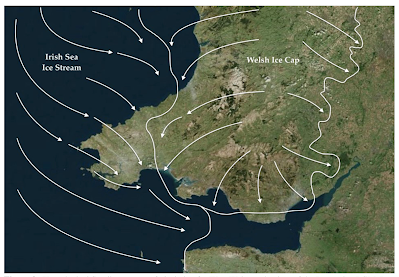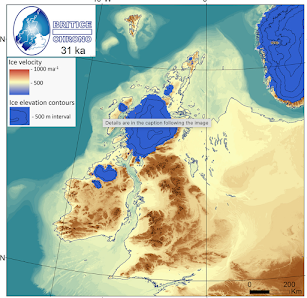In his eternal wisdom, Tim Daw (over on the Sarsen.org blogsite) now seems to be intent on rewriting the laws of physics. He's on about coastal erratics again.
In recent posts he suggests that glacier ice could not have progressed up the Bristol Channel beyond Ilfracombe because the surface gradient on the floor of the channel slopes in the wrong direction. He clearly knows nothing at all about glaciology or glacial geomorphology, or indeed about the laws of physics, because (as I have explained over and again on my blog) ice movement direction id determined by the gradient of the ice surface, and not the gradient of the terrain on the glacier bed. If he reads this, will he please go away and devote a little time to reading some of the geomorphology texts? For a start, he can get a cheap second-hand copy of "Glaciers and Landscape" written by David Sugden and myself, which was the standard text used in universities around the world for more than 20 years. He will discover myriad examples where ice has flowed against the land surface gradient -- as for example at the outer ends of almost all the fjords in the world, where the upslope segments are called "thresholds". Some thresholds involved upslope glacier flow of more than a thousand metres, from -1200 m to around -200m over a distance of less than 20 km. This not theory. It is observed and undisputed fact.
https://brian-mountainman.blogspot.com/2017/01/on-uphill-transport-of-debris-by.html
If he is not satisfied with any of that, Tim might also wish to take a look at the field evidence for glacial deposits from the west, in the Bristol area, as described by multiple research workers over the years. Take for example this:
https://brian-mountainman.blogspot.com/2011/09/ulster-white-limestone-at-kenn.html
Tim then suggests that "icebergs" were responsible for dropping boulders around the coasts of the North Sea, as for example in the freezing weather of 1565, and he provides spectacular and fanciful illustrations in support of his hypothesis. There were no icebergs in the North Sea in 1565 or at any other time in the Little Ice Age. Sea ice occasionally formed, and sometimes broken sea ice floes were piled up along shorelines by the force of tides, waves and winds -- some of these accumulations of broken slabs might well have been 6m high. Some debris might have been moved, since shoreline sea ice in the middle latitudes does sometimes incorporate sand and pebbles as a natural consequence of freezing-on; but to suggest that multiple erratic boulders were redistributed by this process is preposterous, defying the laws of physics.
Next, Tim suggests that the erratic boulders around the shores of the Bristol Channel may all have been emplaced during tsunamis such as that proposed by Haslett and others for the year 1607. He goes to great lengths to explain that large boulders can be moved by massive turbulent water flow under certain circumstances. That is true -- I have seen boulders weighing a tonne or more moving in glaciofluvial meltwater rivers on steep gradients at times of peak flow. But the long-distance transport of boulders by tsunami waves is perfectly nonsensical, and it is misleading to pretend that the 1607 tsunami theory of Bryant and Haslett (2007) is widely accepted. It is not, and while it is indisputable that there was huge storm damage on the Bristol Channel coasts on 30 January 1607, the consensus is that the damage arose because of an exceptional storm surge. To quote from Wikipedia:
...........because of high wave energy conditions it is not methodologically possible to distinguish between storm and tsunami boulder deposits on North Atlantic coasts.[17]In attributing the flood to a storm surge in their 2006 paper,[8] Horsburgh and Horritt show that those proposing a tsunami hypothesis underestimate the volume of water and coastal damage involved in storm surges, and fail to account for flooding on the opposite side of the country on the same day. There is also a lack of evidence for the event affecting West Wales, Cornwall, or southern Ireland. Their tsunami modelling showed that it would not be possible for a tsunami not to affect these areas, while causing flooding elsewhere in the country. Contemporary sources also indicate the flooding proceeded for a period of five hours, which is consistent with a storm surge rather than a tsunami.[8][18]
I agree with Horsburgh and Horritt, and from my intimate knowledge of the coastline of Pembrokeshire I can say that I have never seen anything that supports the idea that there was a gigantic tsunami in 1607 or at any other time that was responsible for refashioning the coastline and redistributing sediments on a large scale.
Time to move away from all these fantasies, Tim, and get real?












































